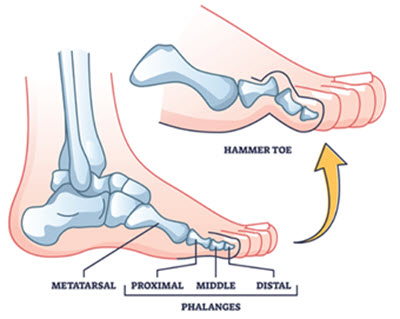Podiatry Coding & Billing Alert
Get the Answers to All Your Frequently Asked Hammertoe Questions
Stay flexible on coding all the possible treatment options. Hammertoe is a relatively common condition seen in podiatry practices. But just because it is common doesn’t mean it’s easy to code: there are different types and degrees of hammertoe conditions and treatments vary from over-the-counter (OTC) medications to surgery. That means podiatry coders always have a lot of questions regarding coding the condition correctly. Fortunately, we’ve assembled all the answers you need in this handy FAQ. Question: What is a hammertoe, and how is it caused? Answer: According to the American Academy of Orthopedic Surgeons (AAOS), hammertoe “is a deformity of the second, third or fourth toes … [where] the affected toe is bent at the middle … [or] proximal interphalangeal (PIP) joint … so that it resembles a hammer” (orthoinfo.aaos.org/en/diseases- conditions/hammer-toe/) The AAOS goes on to tell you that the condition “is the result of a muscle imbalance that puts pressure on the toe tendons and joints…. If the toe is bent in one position long enough, the muscles and joints tighten and cannot stretch out.” The most common cause of this muscle imbalance is wearing ill-fitting shoes, especially “shoes that narrow toward the toe [that] push the smaller toes into a flexed (bent) position,” and “shoes with a higher heel [that] force the foot down and push the toes against the shoe, increasing the pressure and the bend in the toe,” according to the AAOS. Hammertoe can also be congenital, meaning the muscle imbalance can be present from birth. This is important, as coding for congenital and acquired hammertoe is different. Question: What is the correct ICD-10-CM code for hammertoe? Answer: The codes for acquired hammertoes are easily located among the Diseases of the Musculoskeletal System codes. You have three to choose from based on your podiatrist’s documentation: You’ll find the code for congenital hammertoe also where you would expect it: in with the Congenital Malformations, Deformation, and Chromosomal Abnormalities codes. You’ll use Q66.89 (Other specified congenital deformities of feet) as Hammertoe, congenital, is one of the specified deformities listed under the condition. Excludes1 alert: Before you choose the most appropriate code for the condition your podiatrist has documented, be sure you pay attention to the instructional notes that accompany the parent codes. The M20.- (Acquired deformities of fingers and toes) codes, for example, contain an Excludes1 instruction to code congenital deformities and malformations of fingers and toes, which include Q66.89, instead of an acquired hammertoe code when applicable. There is also a reciprocal Excludes1 note for the M20.- codes under the Q66.- codes, which extends to several other acquired foot deformities coded to M21.- (Other acquired deformities of limbs). Question: What are the usual treatment options for the condition, and how are they coded? Answer: Podiatrists can draw on a wide range of treatment options, which will depend on whether the hammertoe is rigid or flexible: Depending on the condition’s severity, several coding possibilities then come into play. Code for the E/M: For flexible hammertoes, often your podiatrist will simply recommend the patient wear different shoes, perform certain exercises, or take OTC or prescription-strength non-steroidal anti-inflammatory drugs (NSAIDs). In this case, you would simply document your podiatrist’s exam, recommendations, and counseling with a lower-level office/ outpatient evaluation and management code from 99202-99215 (Office or other outpatient visit for the evaluation and management of a new/established patient …). Code for the X-ray: You podiatrist may also order X-rays of the patient’s foot. If your practice owns the X-ray machine, you will also be able to bill for that using either 73620 (Radiologic examination, foot; 2 views) or 73630 (Radiologic examination, foot; complete, minimum of 3 views). Remember: If your podiatrist sees there is a need to correct the patient’s hammertoe surgically, you will need to submit the views to confirm medical necessity for the procedure. Code for toe strapping: The podiatrist may decide to start with a toe strapping 29550 (Strapping; toes). In this way, “the podiatrist can evaluate whether the patient would benefit from orthotic inserts. But remember that 29550 is for toes, so you may only bill for one, even if multiple toes are strapped,” suggests Jeri L. Jordan, CPC, billing manager at Hampton Roads Foot and Ankle in Williamsburg, Virginia. Code for orthotics: The patient may find OTC remedies such as corn pads may alleviate pain from hammertoe. But your podiatrist may recommend an orthotic the patient can insert into their footwear for pain relief. You’ll find the codes you need in the orthotic section of HCPCS, most likely among the L3000-L3030 codes. Code for injections: Another treatment option for your podiatrist may be steroid injections in the patient’s toe to alleviate the swelling and pain. Here, you’ll claim for the steroid or other anti-inflammatory using a HCPCS level II code such as J1700 (Injection, hydrocortisone acetate, up to 25 mg), J1710 (Injection, hydrocortisone sodium phosphate, up to 50 mg). or J1720 (Injection, hydrocortisone sodium succinate, up to 100 mg). You’ll also use 20600 (Arthrocentesis, aspiration and/or injection, small joint or bursa (eg, fingers, toes); without ultrasound guidance) assuming the provider did not use guidance for the injection administration, as the example in the descriptor tells you this is the appropriate code for a small joint such as a toe. Code for surgery on a flexible hammertoe: To fix a flexible hammertoe, the surgeon can perform a flexor tendon release, or tenotomy, which you’ll report with 28232 (Tenotomy, open, tendon flexor; toe, single tendon (separate procedure)). “Often times this less invasive procedure will give full relief to the patient with minimal recovery time. But be aware that 28232 cannot be billed with 28285 [Correction, hammertoe (eg, interphalangeal fusion, partial or total phalangectomy)] for the same toe. If two separate toes are repaired on the same day, you may bill with the 59 modifier [Distinct procedural service],” advises Jordan. Code for surgery: To fix hammertoe permanently, the patient will need surgery, and for rigid hammertoe, surgery is the only possible treatment option. During the procedure, the surgeon will roughen up the cartilage on the base of the middle phalanx to promote arthrofibrosis, and the toe is then straightened and fixed with a K-wire. In this situation, you can report this procedure with 28285. 


Related Articles
Podiatry Coding & Billing Alert
- Wound Repair, Part 2:
Conquer All Your Adjacent Tissue Transfer Challenges With 3 Tips
Hint: Use square centimeters for ATTs. In Podiatry Coding and Billing Alert volume 14, number [...] - E/M MDM:
Take These 3 Tips for Effective Data Counting
And refresh your understanding of the 2023 E/M changes. Of the three elements that define [...] - Condition Spotlight:
Get the Answers to All Your Frequently Asked Hammertoe Questions
Stay flexible on coding all the possible treatment options. Hammertoe is a relatively common condition [...] - You Be the Coder:
Paint the Whole Picture for This Podiatric Pathologic Fracture
Question: My podiatrist saw a patient who fractured his right foot. The patient was diagnosed with [...] - Reader Questions:
Pair This Code With Callus Paring Procedures
Question: One of our providers sometimes states she “pares a callus with a Dremel tool,” and [...] - Reader Questions:
Rule out Definitive Dx in This Suspected Achilles Rupture
Question: How do I document an Achilles rupture diagnosis that our provider describes as “probable,” “suspected,” [...] - Reader Questions:
Do a Double Take on This Bilateral E/M Problem
Question: If a patient has a bilateral problem (for example, the patient has rheumatoid arthritis of [...]




